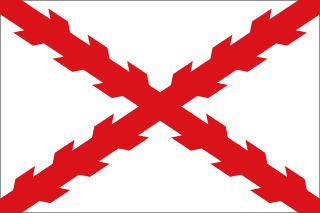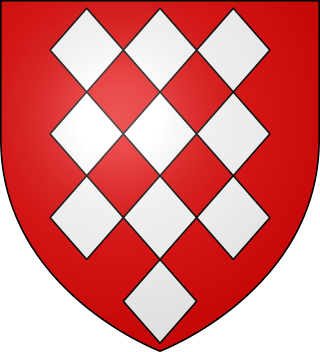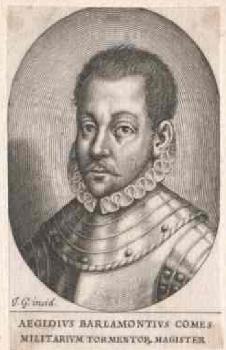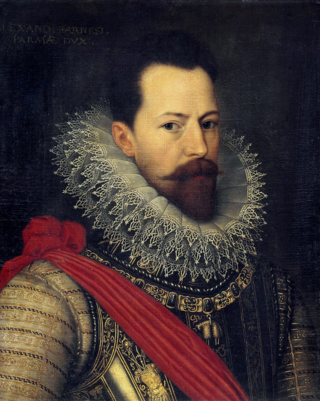
The United Provinces of the Netherlands, officially the Republic of the Seven United Netherlands, and commonly referred to in historiography as the Dutch Republic, was a confederation that existed from 1579 until the Batavian Revolution in 1795. It was a predecessor state of the present-day Netherlands and the first independent Dutch state. The republic was established after seven Dutch provinces in the Spanish Netherlands revolted against Spanish rule, forming a mutual alliance against Spain in 1579 and declaring their independence in 1581. It comprised Groningen, Frisia, Overijssel, Guelders, Utrecht, Holland and Zeeland.

The Seventeen Provinces were the Imperial states of the Habsburg Netherlands in the 16th century. They roughly covered the Low Countries, i.e., what is now the Netherlands, Belgium, Luxembourg, and most of the French departments of Nord and Pas-de-Calais (Artois). Also within this area were semi-independent fiefdoms, mainly ecclesiastical ones, such as Liège, Cambrai and Stavelot-Malmedy.
The Pragmatic Sanction of 1549 was an edict, promulgated by Charles V, Holy Roman Emperor, reorganising the Seventeen Provinces of the present-day Netherlands, Belgium, and Luxembourg into one indivisible territory, while retaining existing customs, laws, and forms of government within the provinces.
The Union of Arras was an alliance between the County of Artois, the County of Hainaut and the city of Douai in the Habsburg Netherlands in early 1579 during the Eighty Years' War. Dissatisfied with the religious policies of rebel leader Prince of Orange and the States General of the Netherlands, and especially the rise of the radical Calvinist Republic of Ghent since October 1577, they signed a declaration on 6 January 1579 about their intent to offer a vigorous defense of the Roman Catholic religion against what they saw as encroachments by Calvinists in other provinces. These signatories would begin negotiations for a separate peace with the Spanish Crown, which resulted in the Treaty of Arras of 17 May 1579.

The Eighty Years' War or Dutch Revolt was an armed conflict in the Habsburg Netherlands between disparate groups of rebels and the Spanish government. The causes of the war included the Reformation, centralisation, excessive taxation, and the rights and privileges of the Dutch nobility and cities.

The Act of Abjuration is the declaration of independence by many of the provinces of the Netherlands from their allegiance to Philip II of Spain, during the Dutch Revolt.
The Generality Lands, Lands of the Generality or Common Lands were about one fifth of the territories of the United Provinces of the Netherlands, that were directly governed by the States-General. Unlike the seven provinces of Holland, Zeeland, Utrecht, Guelders, Overijssel, Friesland and Groningen, these territories had no States-Provincial and were not represented in the central government. At the time of the Union of Utrecht, these territories were under Spanish control, and would only be conquered by the Dutch Republic later in the war. From an economic point of view, they were exploited with heavy taxes and levies. As one author puts it:
"Back in the Dutch lap, these so-called Generality lands were for a long time governed as a sort of internal colonies, in which Catholics were seen as second-class citizens."

The Twelve Years' Truce was a ceasefire during the Eighty Years' War between Spain and the Dutch Republic, agreed in Antwerp on 9 April 1609 and ended on 9 April 1621. While European powers like France began treating the Republic as a sovereign nation, the Spanish viewed it as a temporary measure forced on them by financial exhaustion and domestic issues and did not formally recognise Dutch independence until the Treaty of Westphalia in 1648. The Truce allowed Philip III of Spain to focus his resources elsewhere, while Archdukes Albert and Isabella used it to consolidate Habsburg rule and implement the Counter-Reformation in the Southern Netherlands.

The Burgundian Circle was an Imperial Circle of the Holy Roman Empire created in 1512 and significantly enlarged in 1548. In addition to the Free County of Burgundy, the Burgundian Circle roughly covered the Low Countries, i.e., the areas now known as the Netherlands, Belgium and Luxembourg and adjacent parts in the French administrative region of Nord-Pas-de-Calais. For most of its history, its lands were coterminous with the holdings of the Spanish Habsburgs in the Empire.

George de Lalaing count Rennenberg, was stadtholder of Friesland, Groningen, Drenthe and Overijssel in the service of Philip II of Spain from 1577 to 1581. The Lalaing family came from Hainaut and had a tradition of governing. His father was Philip de Lalaing, count of Hoogstraten; his mother, Anna of Rennenberg.

Habsburg Netherlands was the Renaissance period fiefs in the Low Countries held by the Holy Roman Empire's House of Habsburg. The rule began in 1482, when the last Valois-Burgundy ruler of the Netherlands, Mary, wife of Maximilian I of Austria, died. Their grandson, Emperor Charles V, was born in the Habsburg Netherlands and made Brussels one of his capitals.

Gilles van Berlaymont was stadtholder for the Spanish Crown of Drenthe, Friesland, Groningen and Overijssel (1572-1573), stadtholder of Guelders (1572–1577), substitute stadtholder of Holland, Zeeland and Utrecht (1574–1577), stadtholder of Namur and Artois and baron of Hierges.
The Malcontents in the context of the Eighty Years' War or the Dutch Revolt were a faction of Catholic nobles in Hainaut and Artois who openly opposed William the Silent, also known as William of Orange, the leader of the States General of the Netherlands in the Union of Brussels of the Habsburg Netherlands during the period after the adoption of the Pacification of Ghent. They formed the Union of Arras in January 1579 and negotiated a separate peace with the Spanish Crown, represented by the royal governor-general Alexander Farnese, Duke of Parma, in the form of the Treaty of Arras (1579), signed on 17 May 1579.

The Calvinist Republic of Ghent was a Calvinist republic that existed between 1577 and 1584 in the Flemish independent city of Ghent.

Netherlands–Spain relations are the bilateral relations between the Netherlands and Spain. The relations between both countries are defined mainly by their membership in the European Union and by being allies in the NATO.

The period between the Pacification of Ghent, and the Unions of Arras and Utrecht constituted a crucial phase of the Eighty Years' War between the Spanish Empire and the rebelling United Provinces, which would become the independent Dutch Republic. Sometimes known as the "general revolt", the period marked the only time of the war where the States–General of all Seventeen Provinces of the Habsburg Netherlands, except Luxemburg, were in joint active political and military rebellion against the Spanish Imperial government through the Pacification of Ghent. The Pacification formulated several agreements amongst the rebellious provinces themselves, and laid down their demands – including the immediate withdrawal of foreign troops from the Netherlands, restitution of old rights and privileges, and self-rule – to king Philip II of Spain.

The years 1579–1588 constituted a phase of the Eighty Years' War between the Spanish Empire and the United Provinces in revolt after most of them concluded the Union of Utrecht on 23 January 1579, and proceeded to carve the independent Dutch Republic out of the Habsburg Netherlands. It followed the 1576–1579 period, in which a temporary alliance of 16 out of the Seventeen Provinces' States–General established the Pacification of Ghent as a joint Catholic–Protestant rebellion against the Spanish government, but internal conflicts as well as military and diplomatic successes of the Spanish Governors-General Don Juan of Austria and Alexander Farnese, Duke of Parma split them apart, finally leading the Malcontent County of Artois, County of Hainaut and city of Douai to sign the Union of Arras on 6 January 1579, reverting to Catholicism and loyalty to the Spanish crown. In response, most of the remaining rebel provinces and cities would forge or later accede to the Union of Utrecht, a closer military alliance treaty that would go on to become the most important fundamental law of the United Provinces, who on 26 July 1581 proclaimed the Act of Abjuration, a de facto declaration of independence from Spain. While the nascent polity was struggling to find a new sovereign head of state, including Matthias of Austria, Francis of Anjou, William "the Silent" of Orange and Robert of Leicester, before giving up and deciding to become a republic by passing the Deduction of Vrancken on 12 April 1588, the Duke of Parma continued his successful military and diplomatic offensive, bringing ever more provinces and cities in the southern, eastern and northeastern parts of the Netherlands back into royalist hands. Parma's reconquests more or less stalled after the Fall of Antwerp (1585), and finally came to an end with the failure of the Spanish Armada and Philip II ordered him to intervene in the French Wars of Religion to prevent the Succession of Henry IV and France becoming a Protestant kingdom. These developments gave rise to a new phase, the Ten Years (1588–1598), that saw significant conquests by the Dutch States Army under the leadership of stadtholders Maurice of Nassau and William Louis of Nassau-Dillenburg, and the Dutch Republic's rise as a commercial great power.













